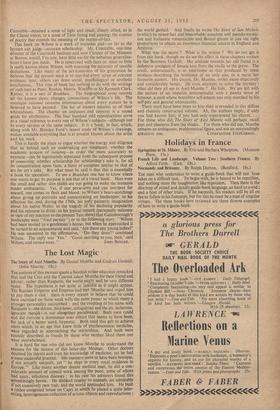The Synthesis of Landscape
Richard Wilson. By W. G. • Constable. (Routledge and Kegan Paul. 70s.) ENGLISH Landscape painting is as unique as the English weather— and indeed the two are closely connected. The Mediterranean landscape lent itself to Classic interpretation because, at its most typical, it is placid, clear and "infinite" as a smooth lake. Certainly there are mountains and forests and rocks, but all are laid out under an undisturbed, constant light, the perspective of which can lull the spectator into a mood of timeless wondering—et ego in Arcadia. The Northern landscapes of France., Germany and the Low Countries are the exact opposite in character. Their light particularises rather than generalises. Instead of a smooth endless lake one thinks of a hard coast-line. The Northern painter navigates the spectator through his landscapes; the Southern painter entices him. The landscapes of this country combine the mood and qualities of both South and North. What perspective does for the Classic landscape, mists and clouds do for us. Compare, for example, Claude with Turner, Chirico with Paul Nash. Or, to be more practical: in Italy one wonders what will next appear over the horizon; here one wonders what will appear round the corner. We share with Classic landscapes a sense of spatial mystery, a sense of scenes existing beyond the immediate one; and at the same time we share with the North a sense of domesticity and particular intimacy. No one expressed this better than Wordsworth.
The importance of Richard Wilson is that he was the first painter, as Turner was the last, to attempt to make this synthesis. He accepted the Classic convention of his time, visited Italy, admired Gaspard Poussin and Claude, but gradually, and to the detriment of his contemporary reputation, followed up his equal admiration for Cuyp, and began to apply, not impose his classic vision to the particulars of the British scene. (A mountaineering friend of mine has said that it would almost be possible to plan an actual ascent from one of Wilson's pictures of Welsh mountains.) The British school of landscape painting followed, and at its best—even in
Constable—retained a sense of light and space, closely allied, as in the Classic vision, to a sense of Time fusing and passing: the essence of poetry that extends the meaning of the matter-of-fact.
This book on Wilson is a work of immense and—so far as the laymen can judge—accurate scholarship. Mr. Constable, one-time director of the Courtauld Institute and now Curator of the Museum at Boston, would, I'm sure, have little use for the nebulous generalisa- tions I have just made. He is concerned with facts or, since so little is really known about Wilson, with assessing the accuracy of specific deductions. Like many of the art-historians of his generation he believes that the present need is to marshal every scrap of relevant evidence; later, others can draw social, psychological or aesthetic conclusions. This type of book has nothing to do with the writings of such men as Pater, Ruskin, Morris, Woelffin or Sir Kenneth Clark. Rather, it is a sort of Bradshaw. The biographical essay records all the known dates, changes, connections of Wilson's life. The catalogue raisonne contains information about every picture he is believed to have painted. The list of owners informs us of their whereabouts. The chapter on imitators and copyists is a sound guide for attributions. The four hundred odd reproductidns serve as a visual reference to every one of Wilson's subjects—although not to every veirsion of the same subject. It is a book, in fact, which, along with Mr. Brinsley Ford's recent study of Wilson's drawings, makes available everything that is at present known about the artist ' and his work.
This is hardly the place to argue whether the energy and diligence that lie behind such an undertaking are misplaced, whether the academic process of isolating—in order the more accurately to examine—can be legitimately separated from the subsequent process of connecting, whether scholarship for scholarship's sake is, for all its concentration upon facts, a form of escapism similar to that of art for art's sake. But what must be said is that this is essentially a book for specialists. To use a Bradshaw one has to know where one wants to go; its purpose is not that of a travel book. Here even the small and rather dim platers are not going to make the tentative reader enthusiastic. Yet, if one perseveres and can interpret for oneself, one comes to flesh and blood: to Wilson's heart-searchings about giving up portraits and concentrating on landscapes: to his affection for, and, during the 1760s, his truly painterly imagination about his native Wales: to the tragedy of his declining popularity and his recourse to drink: to his typical remark (personally welcome in view of my reaction to the present Tate show) that Gainsborough's landscapes were "fried parsley"; or to the following story: "Wilson had been invited to a gentleman's house, but when he approached it he turned to an acquaintance and said, 'Are there any young ladies?' He was answered in the affirmative.. 'Do they draw?' continued Wilson. The reply was 'Yes.' Good morning to you, then,' said



























 Previous page
Previous page